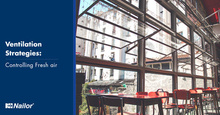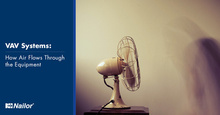Nailor Airwaves is your source for content on relevant topics concerning Nailor Industries, Inc. and the HVAC industry. New product releases, case studies, product & project spotlights, employee interviews, trade publication articles, and general announcements are some of the content types you can expect to find in the Nailor Airwaves.
Nailor Airwaves
5 Variables to Consider when Choosing a Horizontal Fan Coil

Chilled water fan coils are small air handling units that range from 200-4,000 CFM. Several commercially available product types serve multiple applications. In some instances, choosing which product is best for your application is difficult. There are two main configurations: vertical & horizontal. Horizontal units are typically located above a ceiling while vertical units are installed in a closet or exposed in the room. The selection between vertical and horizontal are made during the building design phase, and there will be little debate over where the project needs a horizontal or vertical. Choosing the right horizontal product for an application requires an understanding of the types available.
Horizontal Fan Coils
While the base building blocks of a chilled water fan coil are… Read more
Ventilation Strategies: Chilled Water Fan Powered Terminal Units

The most advanced system for delivering, controlling, and optimizing ventilation air utilizes Chilled Water Fan Powered Terminal Units. With this system, the DOAS unit handles the conditioning of the ventilation air and the latent load within the building. The system eliminates the need for the recirculating air system to handle latent loads and distributes the sensible cooling into the space.
Achieving this system requires series fan-powered terminal units that are equipped with a sensible cooling coil, eliminating the need for the building air handling unit.
Chilled Water Fan Powered Terminal UnitsChilled water fan-powered terminal units contain the following parts:
Flow Sensor
Damper
Fan
Sensible Cooling Coil
Optional – Heating Coil
The dedicated outside air unit supply is ducted to… Read more
Ventilation Strategies: Chilled Beams vs. Chilled Water Fan Powered Terminal Units

A large portion of the energy exerted by an HVAC system comes from conditioning the outside air required by the mechanical code, which typically reference the ASHRAE 62.1 standard. Increasingly, this is performed separately from the building HVAC system by a Dedicated Outside Air System (DOAS). When designing a DOAS system, one decision is how to distribute the air to the space. In my previous Ventilation Strategies article, I highlight a few methods for ventilation distribution. One method I didn't address in the article was Chilled Beams. Chilled Beams compete with the Chilled Water Fan Powered Terminal Unit as a tool for distributing the ventilation from a DOAS. Understanding how each of these tools work, their limitations, and the considerations for selection will help you… Read more
Ventilation Strategies: Controlling Fresh Air

The first goal when designing an HVAC system is occupant comfort. Comfort includes considering thermal, acoustic (sound), and health conditions delivered by the system. HVAC helps create a healthy environment that is achieved through the delivery of fresh air to the space.
ASHRAE Standard
Recognized as a need in the 1960s, ASHRAE documented this with the first publication of standard 62 in 1973. This standard, now known as 62.1, provides the ventilation requirements and guidelines to achieve a well-ventilated building based on occupancy type. The highlight of 62.1 is the ventilation rate calculation procedures located in Section 6. The primary calculation method includes a per person (Rp) and per area (Ra) ventilation requirement for different occupancies. For example, an office space… Read more
VAV Systems: How Air Flows Through the Equipment

The purpose of using a Variable Air Volume (VAV) system is to add controllability to a diversity of occupancies using only one air handling unit. A constant volume system is like what you have in your home, either off or on. If you apply a constant volume system to a space with multiple heating/cooling load profiles, someone will not be comfortable at different times of operation. The fundamental parts of a VAV system include:
Air handling unit
Primary ductwork
Terminal unit
The ductwork/air distribution that serves each zone
Each of these works to deliver the right amount of air to a space to control the desired temperature. More details on these components are in my VAV System Components article. It is critical to understand how the air flows through the components of a VAV system and… Read more